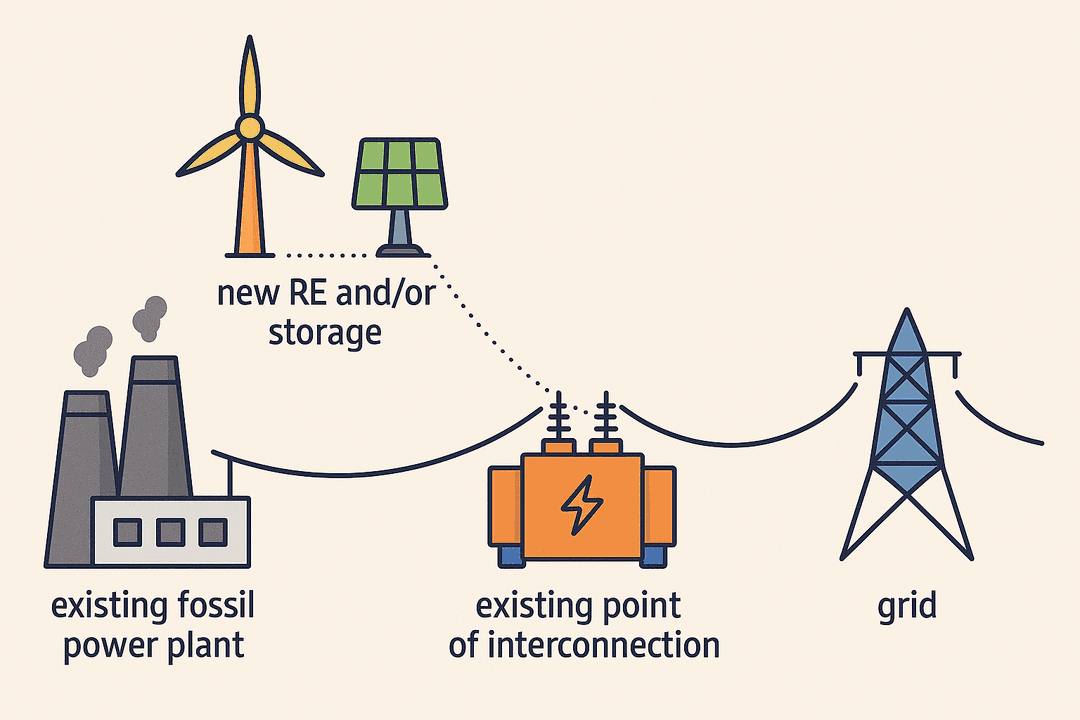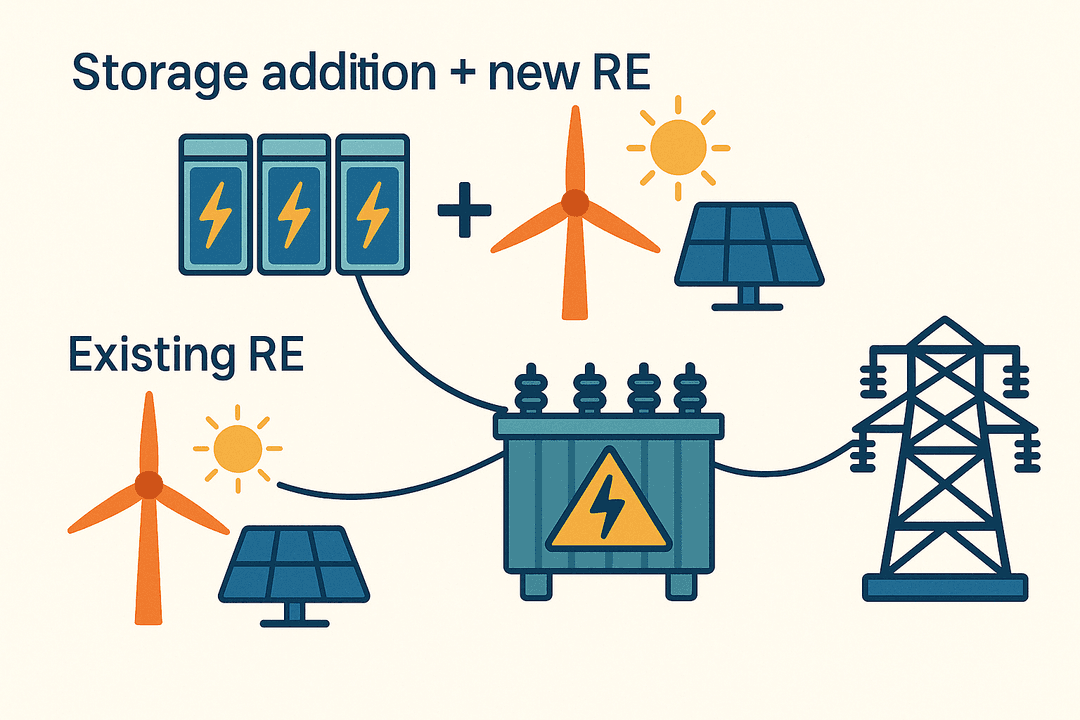SurplusInterconnectionin PJM
Accelerating Clean Energy Deployment by Leveraging Existing Grid Infrastructure
PJM may experience 25 GW shortfalls by 2030 as data center expansion continues with deployment bottlenecks
The Problem
Unprecedented Demand Surge Driven by Data Centers
PJM's electricity demand is projected to surge by 30 GW by 2030, an unprecedented rate of growth. This is overwhelmingly driven by data centers, which are projected to add 17.2 GW of new load and position PJM to host nearly half of all U.S. data center capacity by 2030.
Gridlock in the Interconnection Queue
Low-cost renewable energy projects that could help meet demand face excessive delays. 167 GW of clean capacity is currently stranded in PJM's interconnection queue with average wait times of 3-4 years. This backlog prevents timely deployment of the very resources needed to meet growing demand.
Soaring Capacity Market Prices
Capacity market prices have surged nearly tenfold from $28.59/MW-day to $269.92/MW-day, increasing annual costs to consumers from $2.2 billion to $14.7 billion. This dramatic price spike signals a significant shortfall of firm, dispatchable capacity in the market.
Looming Capacity Shortfall
PJM faces a potential 25.1 GW capacity shortfall by 2030. This gap emerges from a projected 32 GW increase in peak load and 8 GW of retiring generation, which is not being met by the 5.6 GW of realistic additions from the queue and 9.3 GW from the RRI fast-track initiative.
The Solution: Surplus Interconnection
Surplus Interconnection for PJM
Surplus Interconnection Service allows new electricity supply resources to connect to the grid using existing infrastructure that serves already operating generators, without exceeding the total output capacity already allocated to the existing resource. FERC Order 845 (2018) cleared a regulatory pathway for generators to add new electricity resources to the grid by utilizing surplus capacity at existing interconnection points.
Key Results
Available Surplus Capacity
PJM can add 153 GW of clean energy capacity through surplus interconnection, including 102 GW of solar, 28 GW of wind, and 24 GW of energy storage at existing power plant sites.
Meeting Future Demand
This surplus potential can provide 13.6 GW of firm peak capacity (meeting 46% of projected 2030 peak demand growth) and 288 TWh of annual energy (covering 108% of projected energy demand growth), helping address PJM's looming 25.1 GW capacity shortfall.
Time & Cost Benefits
Surplus interconnection projects can be completed in 1-2 years compared to 5-7 years for new interconnections. RE and storage deployment using surplus interconnection can save over $31B in interconnection costs and expensive transmission upgrades.
Thermal Interconnections
Over 52 GW of PJM fossil capacity has capacity factor less than 15%, leaving grid connections unused for significant periods. Moreover, variable costs for many thermal plants already exceed renewable LCOEs, with solar cheaper than 60.8 GW of thermal capacity today. By co-locating new solar and wind generation at these sites, we can bypass lengthy interconnection queues and add cheap electricity while making use of the current infrastructure.

Key Results
Abundant Local Resources
1,782 GW SolarOver 1,782 GW of solar and 214 GW of wind potential exists near PJM thermal plants. This enormous renewable resource can enable clean energy deployment at existing interconnection points.
Urban Area Plants
8.3 GW Capacity20 thermal facilities (8% of total) with 8.3 GW capacity are located in urban areas. We removed these plants from the surplus interconnecton analysis though they are great candidates for adding battery storage after the thermal plants get retired.
Cost-Effective Today
60.8 GW SolarAt 60.8 GW of existing fossil plants, building new solar is already cheaper than running the existing plant. For wind, this is competitive at 126.2 GW of plants today. By 2030, solar will be cheaper than 139 GW.
Ready for Renewables
78.3 GW by 203078.3 GW of renewable energy (73.5 GW solar and 4.8 GW wind) can be economically integrated at PJM thermal plants by 2030
Quick Wins Available
52 GW Ready52 GW of PJM thermal capacity operates at less than 15% capacity factor, leaving grid connections unused most of the time and creating immediate opportunities for surplus interconnection.
Renewable Interconnections
PJM renewable plants have low capacity values (9.5% solar, 41% wind) and poor interconnection utilization (Solar: 19.1%, Wind: 16.1%), meaning expensive grid infrastructure sits idle over 80% of the time. Adding 6-hour storage can dramatically increase capacity factors to 75% for solar and 83% for wind - levels comparable to baseload gas plants, effectively turning variable renewables into firm power resources.

Key Results
Massive Renewable Potential
2,898 GW SolarPJM's existing renewable sites have enormous potential for additional capacity, with approximately 2,898 GW of solar and 348 GW of wind resource potential within 6 miles of existing RE plants.
Significant Storage Potential
23.8 GW StorageAdding 6-hour battery storage at PJM's solar and wind sites would deliver 23.8 GW of firm, dispatchable capacity - helping meet peak demand and enhance grid reliability.
Expanded Renewable Capacity
51.2 GW CombinedPJM's existing renewable interconnections can support additional 28.3 GW solar and 22.9 GW wind, representing a 215% increase in clean energy generation capacity with no new grid connections.
Maximized Utilization
75% Solar | 83% WindDeploying RE and storage at existing interconnections maximizes expensive grid infrastructure usage in PJM, significantly improving interconnection utilization to 75% for solar and 83% for wind plants with 6-hour batteries. This transforms intermittent renewables into firm resources comparable to gas CCGT plants.